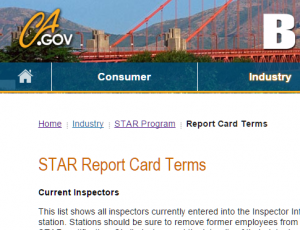Remember back in 3rd grade when you got your report card? Maybe you were an A student, maybe not so much. Maybe you looked forward to showing mom and dad your report card, or maybe you tore it up before you got home.
Well, as a participant in the Bureau of Automotive Repair’s SMOG STAR program, you get a new report card. And like you’re old report card with its A’s and F’s, it’s S’s and O’s, this report card has some terminology. Based on the official document at http://www.bar.ca.gov/Industry/STAR_Program/Report_Card_Terms.html, here are some excerpts:
This list shows all inspectors currently entered into the Inspector Information Table(s) on each Emissions Inspection System being used to perform Smog Check inspections at a station.
Under the new STAR Program, each Smog Check station that intends to inspect directed vehicles must apply to BAR to determine whether the station meets the STAR performance measures. If it is determined that the station meets the standard for each performance measure, BAR will issue a certification to the station making it eligible to inspect directed vehicles.
Overall STAR Result
The Overall STAR Result table summarizes a station’s overall performance on all of the various STAR performance measures. The result of a station’s overall performance will be shown in this table as a “Pass” or “Fail.”
The Station Short-Term Summary shows a station’s results for the following STAR Program performance measures: Test Deviations; Incorrect Gear Selection; and Similar Vehicle Failure Rate (SVFR). Test Deviations are further divided into the following seven performance measures: (1) Fuel Cap Not Performed; (2) Evap Not Performed; (3) Timing Not Performed; (4) OBD II Not Performed; (5) Max Readiness Monitors; (6) ASM Restarts; and (7) Aborted Tests. Together, these ten inspection-based performance measures are considered short-term because they are calculated based on data from the three most recent months.
This STAR performance measure calculates the rate at which each station indicates that a fuel cap pressure test cannot be performed on vehicles when at least 90% of the inspections performed on “similar vehicles” statewide indicate that the fuel cap is testable.
This STAR performance measure calculates the rate at which each station indicates that a Low Pressure Fuel Evaporative Test (LPFET) cannot be performed on vehicles when at least 90% of the inspections performed on “similar vehicles” statewide indicate that the evaporative system is testable.
This STAR performance measure calculates the rate at which each station indicates that a vehicle’s timing is not adjustable, and therefore cannot be tested, when at least 90% of the inspections performed on “similar vehicles” statewide indicate that the ignition timing is testable.
This STAR performance measure calculates the rate at which each station fails to perform the OBD II test on model year 1996 and newer vehicles when at least 90% of the inspections performed on “similar vehicles” statewide indicate that the OBD II system is testable. “Similar vehicles” means vehicles of the same model year, make, model, engine displacement, transmission type, and body style.
This STAR performance measure compares the rate at which each station passes vehicles on the initial test with the maximum allowable unset OBD II readiness monitors to the maximum unset monitor rates for “similar vehicles” statewide.
This STAR performance measure compares the rate at which each station restarts ASM tests on vehicles to the ASM restart rates for “similar vehicles” statewide.
This STAR performance measure compares the rate at which each station aborts inspections (ASM, TSI, Diesel) to the aborted test rates for “similar vehicles” tested on the same brand of emissions inspection system statewide. Inspectors who legitimately abort inspections, for reasons such as previously unidentified safety issues (e.g., a fuel leak), will tend to have abort rates at or below average. Inspectors who abort inspections for other reasons, such as trying to get a vehicle to pass through overconditioning or cleanpiping, will tend to have abort rates above average.
This STAR performance measure compares the rate at which vehicles tested by each station are shifted into the incorrect gear during an ASM inspection to the incorrect gear selection rates for “similar vehicles” statewide. The correct gear in which to drive a vehicle during an ASM test is clearly spelled out in the Smog Check Inspection Procedures Manual.
Similar Vehicle Failure Rate (SVFR)
This STAR performance measure compares the initial test failure rate for vehicles inspected at each station to the initial test failure rate for “similar vehicles” statewide. An initial test may be an official inspection or a pretest and is the first test performed on a vehicle in its current inspection cycle, which may be for biennial inspection, change-of-ownership, or initial registration. “Similar vehicles” means vehicles of the same model year, make, model, engine displacement, transmission type, and body style. Additional factors such as time since last certification, previous initial test result, and odometer readings are also taken into consideration.
Incidents
STAR “Incidents” show specific cases where the inspection results indicate that the inspector followed incorrect test procedures based on a comparison of that inspector’s inspections to test results for similar vehicles throughout the state.
The Follow-up Pass Rate is a long-term STAR performance measure that evaluates the performance of both stations and inspectors. It is the only performance measure that evaluates the performance of an inspector to determine a station’s eligibility for the STAR Program.
For the complete information, refer to http://www.bar.ca.gov/Industry/STAR_Program/Report_Card_Terms.html. Remember, if you are having any type of dispute or issue with the Bureau of Automotive Repair, reach out to one of our BAR attorneys for a consultation. It can be every difficult to wade through the paperwork and requirements on you own, so reach out to us for a consultation.
